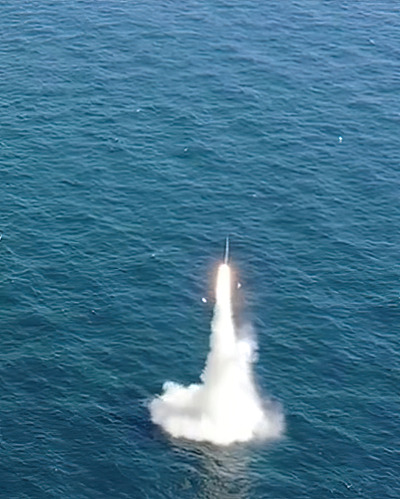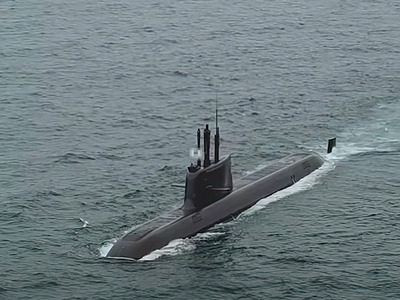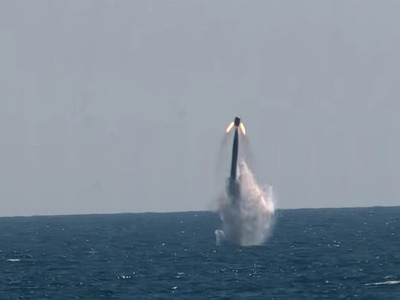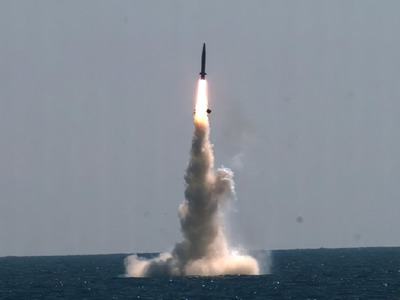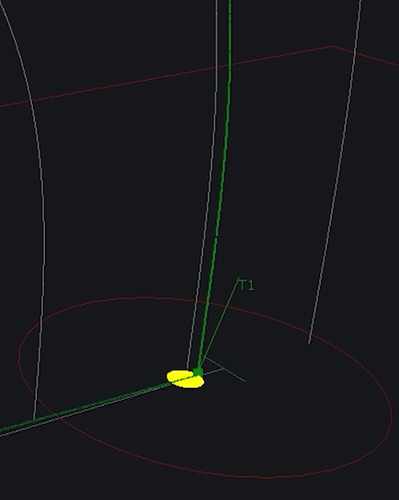I and the Academy of National Defence took note of the recent report made by south Korea.
The funny yet surprising news shows that south Korea tries to rank itself among the world SLBM possessors.
The report said that the agency for defence development of south Korea carried out a SLBM test-launch from 3,000 ton-class submarine "Tosan An Chang Ho" on September 15.
After the test-fire, the south Korean authorities trumpeted that "it is enough to deter the north's provocation" and "south Korea has become a SLBM nation" in their zealous promotion aimed to attach significance to the successful test-launch.
Clear is its aim.
South Korea seems to brag so much about its possession of the underwater weapon generally known as "Game Changer" in the world, thinking that "why only the north, the south also has one". Its inner feelings are fully understandable.
South Korea must have wanted to relieve the increasing security uneasiness in the face of the continued news about missile development by the DPRK, and let the public at home and abroad know that it also became a powerful advanced defence technology possessor.
I have carefully read the news released by south Korea and closely looked at the pictures showing the test-launch.
What was shown in the pictures was clearly not SLBM.
The disclosed pictures show that the weapon has the structure and shape of a typical ground-to-ground tactical ballistic missile. Though the photos could have deliberately been retouched for secrecy, the missile in the picture looked somewhat like a poor weapon without all its shape and far from an underwater weapon.
The questionable weapon looked like a "Hyunmu-serial" missile, short-range ground-to-ground ballistic missile that had already been possessed by the south Korean army.
The outer length is estimated to be about 6 meters and the diameter to be less than 800 mm, and in view of the flame, its range seems to be less than 500 km.
The mode of warhead-cover separation after emergence from water shows that it was an imitation of India's tactical SLBM "K-15".
A tactical-class missile is small in mass at the time of launch, and it is seriously vulnerable to wave, current and the speed of submarine. It, therefore, needs proper underwater attitude maintenance if it is to be launched in deep water. If not, the attitude angle and the change in the attitude angular velocity at the time of emergence become very big, making it hard for the missile to maintain its attitude.
The pictures of the recent south Korea's test-launch show that it was launched in a shallow depth only with the application of cold launch technology without active attitude maintenance underwater.
After the emergence from water, the attitude showed no inclination until the ignition of the missile engine and the size of water column and the amount of water drawn by the missile were small. The reason is that it was launched at a very shallow depth. It can easily be seen that the launch was not made in the middle of operational maneuverability but was made at a stop position or while moving at a low speed.
This proves that core underwater launch technologies like the complicated fluid flow interpretation indispensable for underwater launch have not been completed.
In a word, it was somewhat clumsy "product".
Whatever the purpose, the hasty revelation of the picture which would definitely arouse doubt of all the military experts indicates that south Korea must have been pressed to hastily get around the world the news about its possession of SLBM with its own efforts.
To develop a wholesome SLBM with perfect underwater operational maneuverability and with the capability to give influence enough to tilt the war in one's favor in terms of power, one needs a very high technology and is bound to accumulate a variety of experience in the course of the development.
SLBM is housed in a special and confined small space of submarine and therefore, it is quite different from ground-launched missile and special in technical terms, to say nothing of its shape, structure and movement characteristics. It is virtually modern weapon system requiring complicated technology.
Just bringing a ground-launched missile to the surface of water and igniting it can not turn it to fully-shaped and fully-functioning SLBM.
SLBM differs from ground missile in terms of outer shape and it must meet all tangled major launch conditions of underwater operational environment like depth of the sea and various maritime and meteorological characteristics and environment at the time of maneuverability. What is most important here is missile maneuverability.
It seems from the pictures that tuck-away winglets were attached to the projectile to ensure in-flight maneuverability and stability and that the attitude was controlled with the help of air or gas rudders.
The attachment of the tuck-away winglets to the projectile points to the elementary development stage.
In actuality, SLBM needs to choose its attitude control mode and powerful control ability for setting its attitude right even its attitude is inclined so much as to be about 30 degrees after its emergence from water due to various perturbations to which the weapon is exposed during its underwater passage.
Attitude maintenance during underwater passage is also very important that in some cases fins are attached to the rear part of projectile during the development of SLBM. We have experienced all these processes.
Most of SLBMs possessed by the world's SLBM possessors including the DPRK provide propulsion vector control by rotary jet nozzle.
If what south Korea opened to public and trumpeted so much is SLBM, it is just in the stage of elementary step.
Lots of military experts will also view its practical utility with skeptical eyes.
Such meaningless missile is just for "bragging" and "self-comforting", as it has only hundreds km of flight range and it can load conventional warhead weighing 1-2 ton at most and it is launched from conventional submarine.
Recently, rumor has it that south Korea is going to increase the warhead weight to 3 tons but it can never rival SLBM of other countries loading scores or hundreds kilotons of nuclear warheads.
The missile south Korea revealed to be a SLBM of its own technology can not be the one which will be an effective military attack means in a war.
South Korea's SLBM has not yet reached the stage of being regarded as a weapon of strategic and tactical significance which can be accepted as a threatening means.
But, away from the state of SLBM development by south Korea and its excuses, we have meditated over its purpose of giving attachment to the development of submarine-launched weapon system.
South Korea's ambitious efforts to improve submarine-launched weapon system are a clear omen for the military tension that will be certainly aggravated on the Korean peninsula and this awakens us once again to what we should do.

